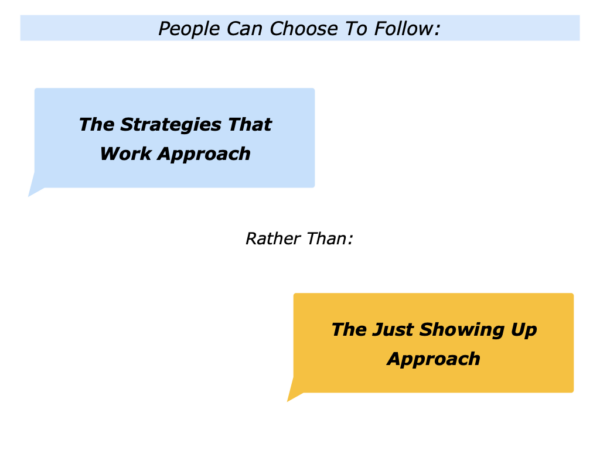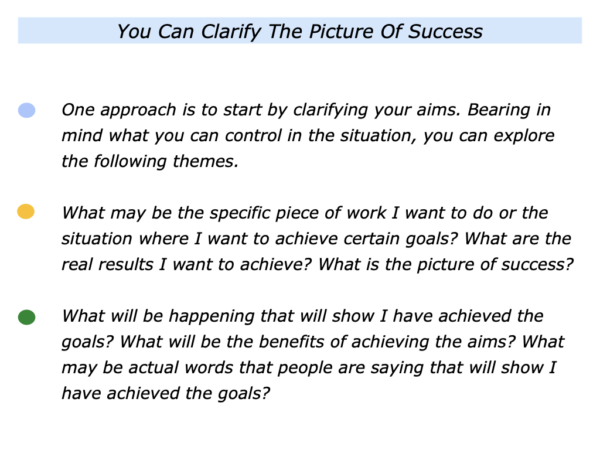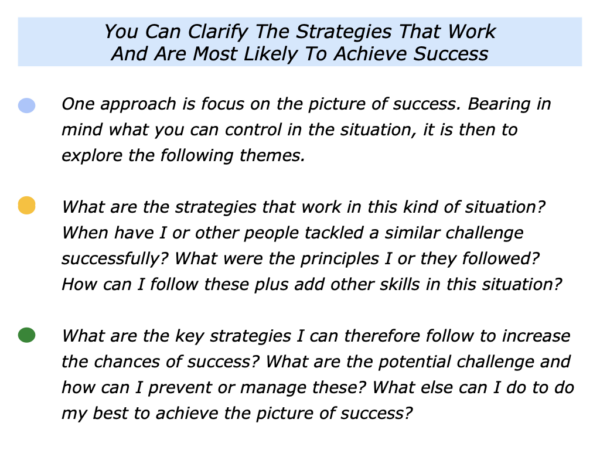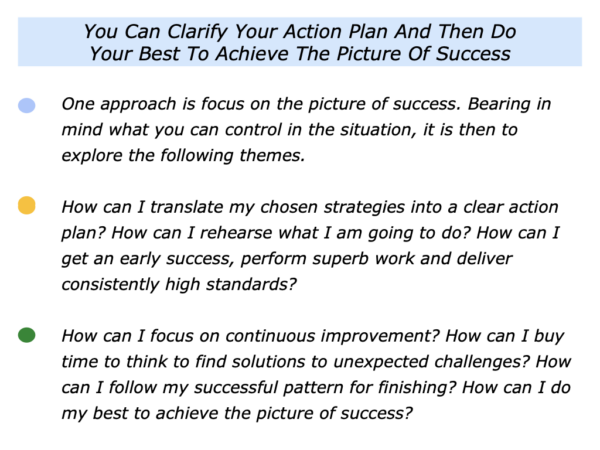
Great workers often follow the strategies that work approach rather than the just showing up approach. One person expressed this in the following way.
“When I was younger I sometimes turned up and used my talent to busk it. But I then reached the stage when this was not good enough and I got caught out.
“I now take the approach that preparing properly increases the chances of producing peak performances. This is my version of the old 7P military saying: Proper Planning and Preparation Prevent Piss Poor Performance.”
There are many ways to prepare properly for different events. You may take this step before doing fine work, communicating with people, having challenging meetings or doing other activities.
One approach is to focus on strategies that work rather than just showing up at the event. Imagine that you want to follow this approach in your own way. This can involve focusing on the following themes.
You can clarify the
picture of success
Imagine that you are preparing for an event. Bearing in mind what you can control in the situation, the first step will be to clarify the real results you want to achieve – the picture of success.
The strategies you focus on will depend on your role and the type of event. Let’s look at some examples.
You may be a person who is going for interview and aim to do your best to get a job;
You may be a leader who aims to communicate the team’s strategy and build with the people who want to contribute towards achieving the goals;
You may be a doctor who is going to share challenging news and outline the possible options to a patient;
You may be preparing for another kind of event where you want to increase the chances of achieving success.
Great workers do lots of research when preparing properly. Bearing in mind what they can control in the situation, they clarify the real results they want to achieve. They then translate this into a clear picture of success.
As mentioned earlier, much depends on the specific event. Whatever the situation, however, there are certain themes it can be useful to explore when clarifying the aims. Here is a summary of these themes.

You can clarify the strategies
that work and are most likely
to achieve the picture of success
Imagine that you have prepared to do a piece of work and have clarified the aims. The next step is to focus on the strategies you want to follow to achieve the picture of success.
Sometimes it can be tempting to launch into brainstorming the possible strategies. Sometimes this can work, but sometimes it can be useful to take another approach. Bearing in mind the results you want to achieve, you can explore the following themes.
When have I or other people tackled a similar situation successfully? What did I or they do right then? What were the principles that were followed? How were these translated these into action? What happened as result?
How can I follow some of these principles – plus maybe add other skills – in the present situation? What other things are likely to work in the situation?
What are the key strategies I can follow to increase the likelihood of success? How can I follow these in my own way? What else can I do to do my best to achieve the picture of success?
Different people follow this approach in different situations. Let’s look at some examples.
A growing company was failing to win as many business pitches as it did in its early days. They tackled this problem by holding inquests into what had gone wrong but this did not seem to work. They then tried another approach.
Looking back, they had won lots of business during the company’s early days. Bearing this in mind, they focused on what they had done right then. This included taking the following steps.
They were hungry for the business … They had done lots of research about the potential client and the challenges they faced … They had clarified how their company could help the client to achieve success.
They had put together a superb pitch team … They had connected with the client to make sure they understood what the client wanted the pitch to focus on … They had prepared properly and rehearsed the pitch.
They had begun the pitch by focusing the client’s goals rather than bigging up their own company … They had given specific examples that resonated with the client … They had shown how they could help the client to succeed.
The company could follow these strategies again – plus maybe add other skills. They returned to putting together hungry pitch teams that connected with the clients and prepared properly. These teams went on to improve the company’s success rate in getting new business.
There are many other examples of how people can focus on following strategies that work. Let’s look at another example.
A leader charged with creating a more professional culture started by communicating the company’s purpose, principles and picture of success. They then built on the people who wanted to contribute towards achieving the goals.
The leader worked with these people to produce success stories that showed how they had followed the professional principles to do superb work. These stories showed what good looked like.
They maintained momentum by continuing to build on the people who wanted to follow the principles. They replaced those who chose not to follow the principles but handled this in a fair and generous way.
The company’s culture became more professional, customer focused and successful. This approach was more effective than spending lots of time trying to change people who did not want to follow the principles.
Let’s return to your own life and work. Imagine that you know the results you want to achieve. Bearing these in mind, you can clarify the strategies that are most likely to work.
You can then build on these strategies and, if appropriate, add other skills. As mentioned earlier, one approach is to explore the following themes. You can then settle on the strategies you want to follow to achieve the picture of success.

You can clarify your action plan
and then do your best to
achieve the picture of success
Imagine that you have settled on your strategies. You can then translate these into a clear action plan. The next step will be to get some early successes, perform superb work and deliver consistently high standards.
You can also focus on continuous improvement. You can then follow your successful pattern for finishing and do your best to achieve the desired picture of success.
Different people take these steps in different ways. Much depends on the kind of specific results they are aiming to deliver. Let’s look at one example.
A senior leader was having difficulties in their relationship with the CEO. They often had strong views on subjects but found it difficult to express these in a way that had a positive impact. They described this in the following way.
“The CEO does not like it when I challenge them. They go through the motions of listening but do not take things on board. This can be difficult, especially when the team makes decisions that are wrong.”
The senior leader’s challenging approach was not working. Bearing this in mind, we focused on the real results they wanted to achieve. This could be summarised in the following way.
They wanted their knowledge to be respected and, when appropriate, taking into account when making decisions.
We explored the strategies that could increase the chances of their views being respected. This involved the senior leader taking a more positive role rather than that of continually challenging people.
Looking ahead, we focused on a forthcoming one-to-one session they were going to have with the CEO. This would involve discussing a specific project the company planned to do.
The senior leader had reservations about the company’s plan and would normally challenge the approach. After some discussion, they decided to try another route. This involved them taking the following steps.
They would contact the CEO ahead of time to agree on the topics to explore in the one-to-one.
They would focus on what the CEO wanted to discuss and also say that, if there was time, there were some topics they would like to discuss to help the business achieve success.
They would make the meeting about the CEO’s agenda and helping them and the business to achieve success.
They would, if time permitted, ask if it was okay to explore the specific project that they has strong views about but they would then behave in a certain way.
They would focus on the results the project aimed to achieve and, instead of challenging the present plan, ask if it was okay for them to outline the possible options for working to achieve the results.
They would, in a considered way, describe what they saw as the pluses and minuses of each option. They would ask the CEO if there were any other potential options.
They would be happy to give their recommendation but they would, of course, aim to make their best contribution to whatever route the leadership team chose to pursue.
The senior leader translated this approach into action. Whilst sometimes needing to bite their tongue, they found the session to be rewarding. It also helped to improve their relationship with the CEO.
Whilst they still had some reservations about the project, they adopted a similar approach in their interactions with colleagues. Instead of challenging people, they looked to the future and offered options.
The senior leader wanted to keep their integrity so there might come a point where they dug their heels in. They took a more positive role in the C-suite, however, and this resulted in more people respecting their knowledge.
There are many ways to do fine work. One approach is to follow strategies that work rather than just show up and busk it. You will, of course, follow this approach in your own way.
Imagine you have clarified the strategies you want to follow. Here is a summary of the themes you may want to explore before moving into action. You can then do your best to achieve the desired picture of success.







Leave a Reply